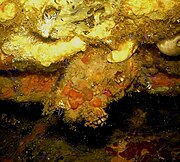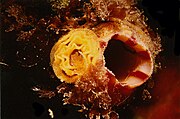|
Microcosmus sabatieri
Microcosmus sabatieri, commonly called the grooved sea squirt,[2] sea fig,[3] or violet,[3] is a species of tunicates (sea squirts). The species has a rocky-shape appearance. It is mainly found in the Mediterranean Sea.[4] It is used as food in parts of Europe.[2] UsesThree species of Microcosmus are edible presently, M. sabatieri, M. vulgaris, and M. polymorphus (Vafidis 2008). [citation needed] In the Mediterranean Basin, it is eaten raw, often with an acidic condiment such as lemon juice or vinegar with shallots.[citation needed] It has a strong iodine taste which not all appreciate.[citation needed] NamesThe specific epithet sabatieri is in honor of zoologist Armand Sabatier.[3] The name 'violet' is from the distinguishing violet stripes on the siphon.[3] The species has many common names. In Dutch it is violet-zakpijp (lit. violet pocket-pipe)[2] or begroeide zakpijp (overgrown pocket-pipe).[3] In French it's violet,[2][3] figue de mer (lit. sea fig),[3] and in Marseille, patate de mer (lit. sea potato),[3] or vioulé.[3] In Northern Catalonia it's called biju or bijut (jewel)[3] and in the Principality bunyol or ou de mar (sea fritter or sea egg).[5] In German the common term is Seefeige (lit. sea fig)[2] or eßbare Seescheide (edible sea sheath).[3] It is Φούσκα (foúska, lit. bubble or puff) in Greek.[4] In Italian, limone di mare (sea lemon) or uova di mare (sea egg) are used.[3] Names in Spanish include provecho (profit), patatas de mar (sea potatoes), and buñuelo de mar (sea fritter).[3] In Ligurian it can be called stronsci de mä (sea turds).[3] In Morocco, in both Moroccan Darija and Berber, it's called fezḍāḍ (فزضاض) or afezḍāḍ (ⴰⴼⴻⵣⴹⴰⴹ, أفزضاض).[6] Other names it is sold under include:
Note that plants of the genus Carpobrotus are also known as 'sea figs'.[7] Gallery
References
External linksWikimedia Commons has media related to Microcosmus sabatieri. |
||||||||||||||||||||||||||||||||||



